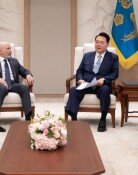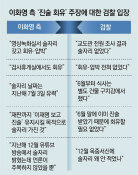Trump puts pressures on N. Korea for ‘permanent denuclearization‘
Trump puts pressures on N. Korea for ‘permanent denuclearization‘
Posted May. 10, 2018 07:48,
Updated May. 10, 2018 07:48
U.S. Secretary of State Mike Pompeo arrived in Pyongyang on Wednesday in his second visit to the North following the first-ever one in early April. During this visit, he reportedly aims to determine the date and venue for the planned U.S.-North Korea summit and to return to his country with three U.S. citizens of Korean descent detained in the North. Just before Pompeo’s arrival in Pyongyang, U.S. President Donald Trump announced a plan to pull out of the Iran nuclear deal. His national security adviser John Bolton said that a clear signal had been sent to the North that the United States would not accept an incomplete deal.
President Trump had mentioned the venue and date of the summit with Kim on Twitter but postponed officially announcing the agreement. In addition, Trump sent Pompeo to Pyongyang to negotiate the U.S. citizens’ releases and raise the level of its negotiation target.
The withdrawal from the Iran nuclear deal is aimed at putting stern pressures on the North for a “real deal” with Pyongyang, just as Bolton put it. He went as far as to saying that Washington’s goal “rests on what North Korea itself agreed to going back to the 1992 joint North-South denuclearization declaration: the elimination of both the front and the backend of the nuclear fuel cycle; no uranium enrichment; no plutonium reprocessing.” He added, “There are other things we’ll be asking for as well,” apparently referring to the problems in the incomplete Iran deal, which the U.S. president called the “worst deal ever.”
Under the 2015 nuclear pact, Tehran agreed to maintain only a stockpile of low-enriched uranium and reduce its centrifuges to one third. However, Trump has claimed that such regulations were due in 10 to 15 years, enabling Iran to resume its nuclear development after the agreement is over. That is why he increased the level of his pressure on Pyongyang from a “complete, verifiable, irreversible denuclearization” to a “permanent, verifiable, irreversible denuclearization.”
North Korean leader Kim Jong Un visited China to meet with Chinese President Xi Jinping just before Pompeo’s visit probably because he needed Beijing’s support against the U.S. pressures. Kim asked for Xi’s support while reiterating his call for “phased and synchronous measures” for denuclearization. However, Pompeo told reporters during his flight back home that Washington would not accept Pyongyang’s attempt to earn time. If Pompeo’s visit to the North makes a Trump-Kim summit official, the two sides will enter into full-fledged negotiations for a roadmap over the U.S. demand of denuclearization and the North’s call for a guarantee of its regime. The real game is just beginning now with a deadline set until the signing of a U.S.-North Korea agreement.







